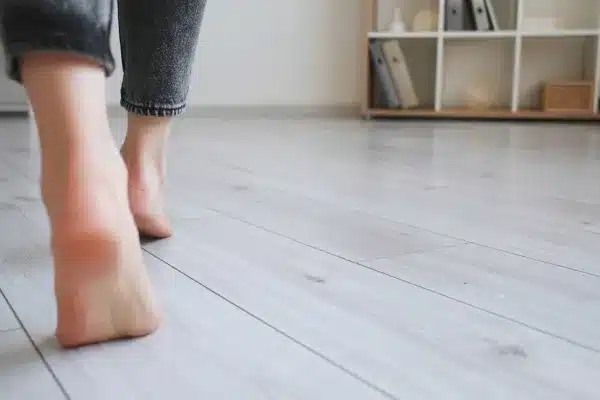Flat feet, also known as pes planus, is a condition where the arches of the feet are either absent or significantly flattened, leading to the entire sole making contact with the ground. While flat feet may seem like a minor issue, they can contribute to a range of other health concerns—particularly joint pain. One of the most significant issues that can arise in people with flat feet is arthritis, a condition that affects the joints and causes pain, swelling, and stiffness.
In this post, we’ll explore the connection between flat feet and arthritis, and provide insight into treatment options for managing the associated joint pain.
How Flat Feet Contribute to Arthritis
The feet are the foundation of the body, and their structure plays a critical role in the alignment of the rest of the body. When a person has flat feet, the lack of proper arch support leads to abnormal pressure distribution on the joints of the foot, ankles, knees, and even the hips and lower back. Over time, this abnormal alignment can lead to the development of arthritis in the affected joints.
There are a few specific ways flat feet contribute to arthritis:
- Increased Stress on Joints
Without a proper arch, the foot tends to overpronate, which means it rolls inward more than it should while walking or running. This misalignment can put excess pressure on the joints in the foot, especially the big toe joint, leading to conditions like hallux rigidus (arthritis in the big toe) or other forms of joint degeneration. - Misalignment and Compensation
The lack of support from the arches can throw off the alignment of the entire lower body. To compensate, other joints such as the knees and hips may overcompensate and experience additional wear and tear, leading to conditions like osteoarthritis or patellofemoral pain syndrome. - Inflammation in the Foot Joints
Flat feet can cause tendons and ligaments in the feet to stretch or become strained. This can lead to inflammation around the joints, increasing the likelihood of developing inflammatory arthritis such as rheumatoid arthritis or psoriatic arthritis.
Treatment Options for Arthritis in People with Flat Feet
If you have flat feet and are dealing with joint pain or arthritis, there are several treatment options to help manage the pain and slow down the progression of joint damage. The goal is to reduce inflammation, improve foot function, and restore alignment to prevent further complications.
- Custom Orthotics
One of the most effective treatments for managing flat feet and associated arthritis is custom orthotics. These shoe inserts are designed specifically to support the foot’s natural alignment, correct overpronation, and provide cushioning to reduce pressure on the joints. Proper orthotics can help alleviate pain in the feet, knees, and hips, and reduce the strain on the affected joints. - Physical Therapy
Physical therapy is an essential treatment for improving foot mechanics and strengthening the muscles surrounding the joints. Exercises that focus on strengthening the arch, improving balance, and increasing flexibility can help reduce the stress on joints caused by flat feet. A podiatrist or physical therapist can guide you through personalized exercises that target your specific needs. - Footwear Recommendations
Proper footwear is crucial for managing both flat feet and arthritis. Shoes with arch support, cushioning, and a stable base can significantly reduce pain and prevent further joint damage. A podiatrist can help you find the right shoes for your specific condition. Avoid wearing shoes that are too flat or have insufficient support, such as flip-flops or worn-out sneakers. - Anti-Inflammatory Medications
Nonsteroidal anti-inflammatory drugs (NSAIDs) can be effective in managing the inflammation and pain associated with arthritis. Over-the-counter medications like ibuprofen can help reduce swelling and provide temporary relief. However, it’s important to consult with your healthcare provider before relying on these medications long-term. - Steroid Injections
In more severe cases, corticosteroid injections may be recommended to reduce inflammation in the affected joints. This treatment provides temporary relief and can help manage arthritis pain, allowing you to continue with your daily activities. However, it’s typically not a long-term solution and should be used sparingly. - Surgical Options
In cases where conservative treatments do not provide sufficient relief, surgery may be necessary. For flat feet, this could involve procedures to correct the alignment of the foot or fuse affected joints to alleviate pain. Joint replacement surgery may be considered if arthritis has caused significant joint damage, especially in the ankle or big toe. - Weight Management
Maintaining a healthy weight is essential for reducing pressure on the feet and joints. Excess weight can worsen the symptoms of flat feet and arthritis, particularly in the lower limbs. A balanced diet and regular exercise can help keep your weight in check and reduce stress on your joints.
Conclusion
Flat feet and arthritis often go hand-in-hand, and the pain they cause can be both debilitating and persistent. By addressing the underlying causes of flat feet and seeking proper treatment, you can manage the symptoms and improve your quality of life. Custom orthotics, physical therapy, proper footwear, and in some cases, medication or surgery, can help alleviate joint pain and restore mobility.
If you’re dealing with flat feet and arthritis, don’t wait to seek help. At Foot Focus, we specialize in diagnosing and treating these conditions, offering personalized care to help you manage pain and improve foot function.
Schedule an appointment with us today to discuss your treatment options!

